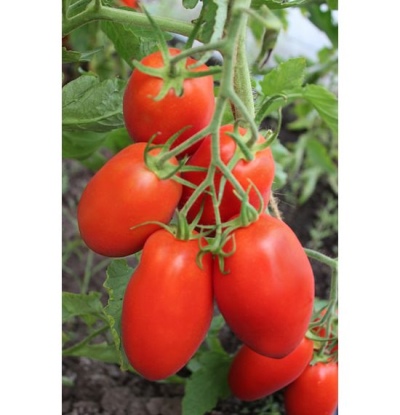
- Authors: Blokin-Mechtalin V.I.
- Year of approval: 2020
- Name synonyms: Vikusya F1
- Category: hybrid
- Growth type: indeterminate
- Appointment: fresh consumption, for pickling and canning, for whole-fruit canning
- Ripening period: early
- Ripening time, days: 90-95
- Growing conditions: for open ground, for film greenhouses, for greenhouses
- Bush size: tall
Russian breeding continues to move forward and surprise with new varieties of promising tomatoes. One of them is Vikusya. It's time to take a closer look at it and make a meaningful decision.
Breeding history
The registration of the plant as admitted to gardening in Russia took place in 2020. The well-known Blokin-Mechtalin became the author of the breeding project. It should be noted that the culture has an official synonym - Vikusya F1. Therefore, it has a pronounced hybrid character.
Description of the variety
Vikusya is one of the indeterminate tomatoes. They can be grown both in conventional and plastic greenhouses. Cultivation in ordinary garden soil is also possible. The bushes reach great heights (1.8-2 m). light green foliage is of medium size.
The main qualities of the fruit
The youngest berries are light green in color. When they grow up, get stronger and fill up, they will turn red. A spot near the stalk will not appear. Medium-sized berries weigh about 90 g (on average for the harvest). In shape, the Vikusya tomato resembles a cylinder.
Typical for him are:
smooth skin;
development from simple inflorescences;
articulated stalks;
laying of the first berry over 7 leaves;
laying of other berries after 1-2 leaves.
Taste characteristics
The pulp of this variety has an excellent density. It is sweet, which is confirmed by the experience of a large number of people. There is a sour taste, but it does not produce an unpleasant effect.
Ripening and fruiting
Vikusya ripens quite early. Between the formation of the first shoots and the formation of developed fruits, it will take from 90 to 95 days. You can shoot berries from July to September.
Yield
Vicusi collection for 1 sq. m can range from 12 to 12.9 kg. Of course, such a result is achieved only with scrupulously verified agricultural technology.
The timing of planting seedlings and planting in the ground
Traditionally, it is necessary to sow seeds in planting containers during March. With this approach, it will be possible to achieve obtaining, of course, viable seedlings during May. Specific dates are selected individually. Summer residents should consider before disembarking:
the degree of soil heating;
the degree of development of the seedlings themselves;
actual and forecast weather.

Growing tomato seedlings is an extremely important process, because it largely depends on whether the gardener will be able to harvest at all. All aspects must be taken into account, from seedbed preparation to planting in the ground.
Landing scheme
Typical placement of 4 tomato bushes per m2. Sometimes 3 bushes are planted to simplify maintenance. The recommended seating system is 500x500 mm.Plants will have to be formed in 2 stems.

Growing and care
Water the plant in a timely manner. At the same time, excessive irrigation is categorically contraindicated. For feeding, the use of complex fertilizers is recommended. Growing in a greenhouse is most advisable. Inside the insulated space, the fruiting period will be maximum.
Otherwise, the approach will not differ from the measures in relation to other early maturing indeterminate tomatoes. It is recommended to soak the seeds in a nutrient solution for 24 hours. Treated pelleted seeds can be planted immediately after purchase, without additional soaking. Self-prepared soil should be disinfected. Watering should be done as regularly as possible.
This is much more correct than irrigating the bushes occasionally, but in large quantities. Tomatoes that receive water rhythmically develop faster and more efficiently. It is recommended to mulch the soil, especially when growing tomatoes in greenhouses. Choose the type of mulch to your liking, and its thickness should be sufficient for full protection and moisture retention. Seedlings transplanted to bright sunny places in the first few days should be covered with spunbond.




A plant needs different micronutrients at each stage of growth. All fertilizers can be divided into two groups: mineral and organic. Folk remedies are often used: iodine, yeast, bird droppings, eggshells.
It is important to observe the rate and period of feeding. This also applies to folk remedies and organic fertilizers.
Disease and pest resistance
The apical rot of the fruit practically does not affect the condition of the Vikusi bushes. Bacterial leaf spot and bacterial wilting are also almost not scary. And also guaranteed protection against viral tobacco mosaic. Pests specific to this variety have not yet been identified. However, the usual preventive measures will still be very helpful.


Growing regions
Vikusya tomatoes are officially approved for cultivation for:
West Siberian;
Volga region;
central black earth;
Moscow region;
living in the north of Russia;
Krasnodar;
Stavropol farmers and gardeners.

























































































